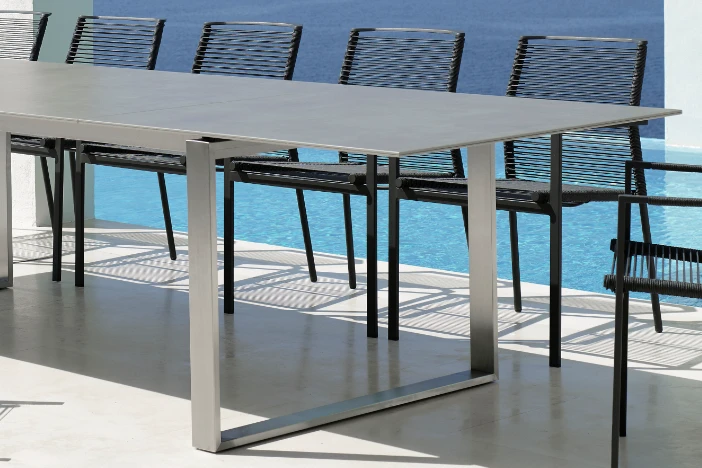
Guidelines for cleaning metal outdoor furniture frames
Metal patio furniture looks great when new. However, it can become embarrassing if it rusts or stains from neglect. Most frames can easily be cleaned using a common process but each metal has its characteristics and nuanced care. This section of our comprehensive looks at several commonly used metals and offers tips on maintaining them.
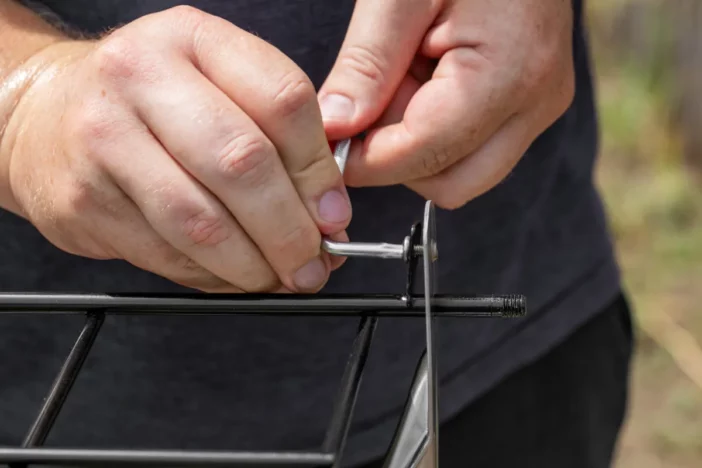
Pre-season checklist for metal deck furniture care
Taking good care of your metal patio furniture at the start of each outdoor season can help it last longer and look better. No matter if it’s made from aluminum, wrought iron, steel, or stainless steel, you should inspect, clean, and protect your pieces. This will help them stay functional and attractive year after year. Use this checklist every spring or before busy outdoor times. It helps you find small problems before they turn into costly repairs.
Pre-season & annual maintenance – Metal
- Uncover & Unpack
Remove furniture from storage or protective covers. Check for moisture build-up, pest activity, or mildew if furniture was stored. - Visual Inspection
Check for rust on joints, welds, screw holes, or hidden surfaces. Inspect for paint or finish damage, such as chipping, bubbling, or discoloration. Look for cracks or dents in frame components that may affect stability. Identify corrosion or tarnish specific to metal type (e.g., white oxidation on aluminum, rust on steel). - Test Structural Stability
Gently shake or apply pressure to each piece to test sturdiness. Ensure no wobbling, leaning, or frame flexing under moderate pressure. - Tighten Hardware
Examine and tighten all bolts, screws, and fasteners. Replace missing or corroded hardware with rust-resistant alternatives. Apply anti-seize or lubricant to threaded joints for easier future maintenance. - Inspect Cushion Attachments
If cushions or sling seats are included, inspect attachment points (clips, screws, straps). Check that any metal clips or support bars are free of rust or sharp edges. - Clean Thoroughly
Wash frames with mild soap and water using a soft cloth or sponge. Use a non-abrasive brush for stubborn grime or textured finishes. Rinse thoroughly and dry completely with a towel to prevent water spotting or rust.
Repairing minor damage
- Treat & Repair
Touch up scratches or chips with metal-compatible paint or protective coating. Use rust converters or removers for minor corrosion, then repaint. For stainless steel, consider applying a dedicated polish or cleaner to remove minor stains and restore shine. - Apply Protective Coatings
For powder-coated, painted, or bare metals, apply a UV-resistant wax, sealer, or metal protectant. For iron or steel, consider a clear enamel spray or rust-inhibiting coating on high-wear areas. Avoid wax on textured finishes unless labeled safe for that use. - Check Feet & Glides
Inspect plastic or rubber feet for wear or cracking. Replace damaged glides to prevent rust where metal touches the ground. Make sure feet are level to avoid rocking or tipping.
Do this every year, preferably in early spring. Also, do light touch-ups or cleanings during the season if needed. Consistent upkeep like this helps metal furniture stay beautiful, safe, and ready for use whenever the sun is shining.
Quick reference – Safe cleaners for metal patio furniture
Using the right cleaner for your metal outdoor furniture helps preserve its finish and prevent corrosion. The chart below shows which cleaning products are safe and which ones to avoid for common metals.
| Metal Type | Avoid These Cleaners | Safe Cleaning Options |
|---|---|---|
| Stainless Steel | Bleach, steel wool | White vinegar, mild dish soap |
| Galvanized Steel | Acidic cleaners (e.g., vinegar, lemon) | Dish soap, baby powder and milk mixture |
| Aluminum | Abrasive pads, ammonia-based cleaners | Mild detergent, automotive wax |
| Wrought Iron | Water alone (if rust is present), acidic rust removers | Rust-inhibiting primer, enamel paint |
Generic metal cleaning steps
- Remove any upholstered cushions or decorative throw pillows
- Lightly spray the metal outdoor furniture frames with a garden hose. This will help remove the biggest pieces of dirt and debris
- Wipe the metallic surfaces down using a soft cloth soaked in soapy water
- Rinse off the cloth and repeat wiping with clean water
- Dry with a microfiber or low-abrasion cloth
Be sure to pay attention to the underside as well as any joints. Avoid using acid, solvent and alcohol-based cleansers, or abrasive wire brushes or pads that may scratch the surface.
Maintenance for different metals, grades & finishes
When it comes to outdoor metal furniture, not all metals—or their finishes—are created equal. The grade and finish of a metal affect its durability, look, resistance to rust, and the maintenance it needs. Knowing the differences can help you better protect your furniture from premature aging and environmental damage.
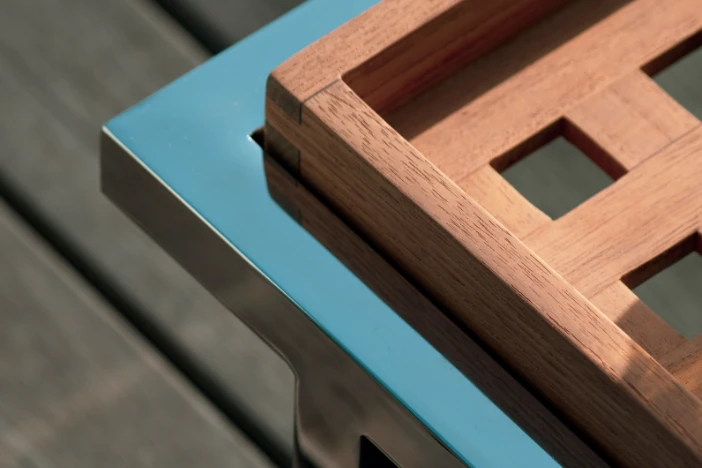
Stainless Steel
Hairline brushed steel frames give outdoor tables and seating a sleek upscale look that looks amazing in a modern outdoor space. However, the slightest spot or discoloration can detract from the sophisticated appeal. Greasy hands and rainfall can result in dirty and spotted metal. Furniture made from 316 marine grade stainless steel will not rust. However, 304 and lower grades can. This is especially true in salty air environments [Kain 1984]. Fortunately, there are simple remedies to keep your stainless steel outdoor furniture in good shape.
General cleaning
- Greasy Fingerprints & Smudges – Rub white vinegar on the area using a damp soft cloth and rinse clean once the blemishes are gone
- Water Marks – Perform a basic cleaning, wipe any excess water from the surface and let it air dry in the shade
- Rust & Corrosion (a.k.a. Tea Staining) – Gently scrub the surface with a paste made of baking powder and water. Use a soft-bristled brush and scrub in the direction of the grain. Rinse the area with fresh water afterward
Cleaning hard water stains (calcium or lime) off steel
Water with a high mineral content can leave a chalky white residue on metal over time. Removing these unsightly stains takes a little extra work.
- Mix a solution of distilled white vinegar and water (25% vinegar for stainless steel and 50% for galvanized steel)
- Apply the solution to the metal with a spray bottle or gently rub it in using a soft cloth
- Rinse a cloth with warm water and wring it out
- Wipe the vinegar solution off with a damp cloth
- Wipe the surface with a dry cloth
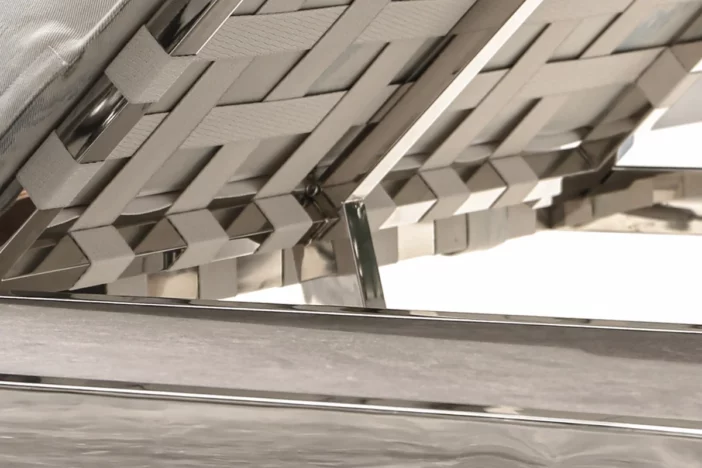
304 Stainless Steel
This is the most common grade used for outdoor furniture. It offers good corrosion resistance in mild to moderate climates and is relatively low maintenance. However, in coastal or highly humid environments, it may develop surface rust over time due to salt exposure
Maintenance tips for 304 stainless steel
- Use mild soap and water for regular cleaning.
- Apply stainless steel cleaner or polish periodically to maintain luster and remove minor oxidation.
- Avoid abrasive pads that can scratch the protective chromium oxide layer.
316 Stainless Steel
316 stainless steel is called “marine grade.” It has molybdenum, which helps it resist corrosion. This is especially true in salty or chlorinated environments. This makes it ideal for coastal areas, poolside settings, and regions with high humidity.
Maintenance tips for 316 stainless steel
- Requires less frequent cleaning but benefits from occasional fresh water rinsing to remove salt or residue.
- Use a pH-neutral cleaner for stubborn grime.
- Still avoid abrasive tools to preserve its polished or brushed finish.
Manufacturer Video Tip – Stainless Steel
Galvanized Steel
A zinc oxide layer protects this matte gray metal from corrosion, but that coating wears down eventually.
Slow the degrading of the zinc oxide layer
You can slow the degradation by cleaning galvanized steel regularly. Using hot water and mild dish soap, scrub the surface in small circular strokes with a soft-bristled brush. Rinse the surface with water and wipe dry with a microfiber cloth.
Neutralizing alkaline deposits on galvanized steel
Galvanized steel may become cloudy and dull over time due to alkaline build-up. This accumulation can also break down the layer of zinc oxide that helps protect the metal from corrosion. To restore galvanized steel’s original finish and maintain its protective layer, there’s an easy DIY solution.
- Mix a solution of 33% baby powder and 67% milk
- Apply the solution to the metallic surface with the toothbrush using small circular strokes
- Rinse with clean water
- Dry thoroughly with a soft cloth
Galvanized steel is coated with a protective layer of zinc to resist rust. This finish offers good protection. However, scratches or chips in the coating can cause corrosion if the metal underneath is exposed.
Maintenance tips for galvanized steel
- Avoid acidic cleaners like vinegar or lemon-based products, which can break down the zinc coating.
- Wash with dish soap and water, and dry thoroughly to prevent moisture from sitting on the surface.
- Reapply protective sealants or touch-up paint as needed to maintain integrity.
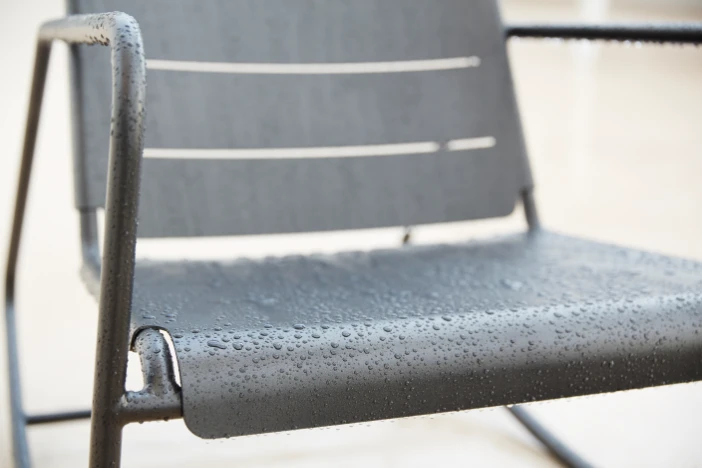
Aluminum
Aluminum is easy to work with and can be used to create a myriad of interesting patio furniture designs. Though strong and lightweight, it’s more susceptible to denting than other metals. Be careful when moving aluminum patio furniture for cleaning or storage. Dents compromise the strength and diminish the protective integrity of any coating.
Powder-Coated
Powder-coated aluminum patio furniture tends to get scuffed in high-traffic outdoor areas. Marks from shoes, tools, toys and lawnmowers should be removed before general cleaning. Non-abrasive liquid cleaners will usually do the trick. Gently rub the cleanser onto any scuff using a cloth and water. It may take a few attempts, but most scuffs should easily come out.
If the original powder coating has a gloss finish, you can retain the shine by applying baby oil or car wax. You can fix scratches with touch-up kits from manufacturers. You can also spray a clear coat to protect the exposed metal.
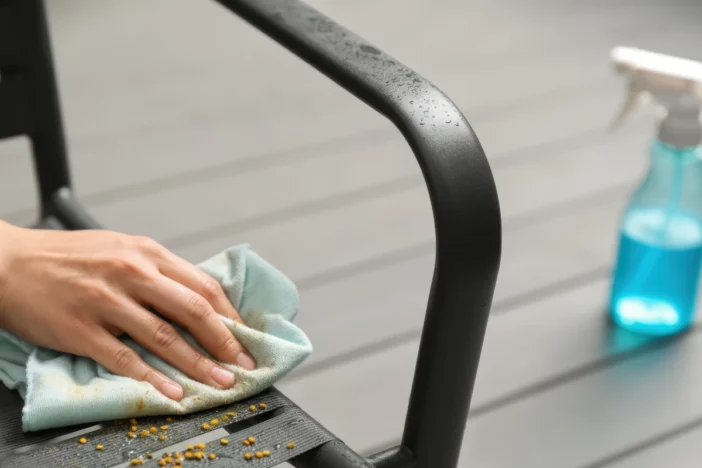
Cast Aluminum
Heavier and more decorative, cast aluminum often has an ornate design and is finished with powder coating for protection. It’s naturally rustproof and well-suited to any climate.
Tubular Aluminum
Lighter and more affordable, tubular aluminum is more common in budget-friendly patio furniture. It’s also rust-resistant but may dent more easily than cast versions.
Maintenance tips for both cast & tubular aluminum
- Clean with a mild detergent and soft cloth.
- Inspect powder coating regularly; touch up chips to prevent corrosion at exposed areas.
- Avoid ammonia-based products that can dull the finish.
Manufacturer Video Tip – Aluminum
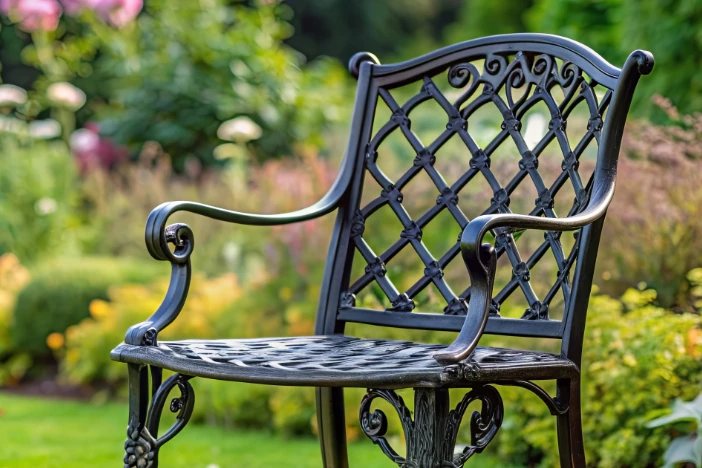
Wrought Iron
Some wrought iron patio furniture has intricate textures with various nooks and crannies. This makes them more difficult to keep clean than other metal patio chairs and tables.
Cleaning dust from wrought iron patio furniture
They tend to collect dust, so vacuum using a small brush attachment to remove as much loose dirt as possible. Follow the basic steps for cleaning metals, using a narrow nylon scrub brush or toothbrush on tight curves and crevices.
Caring for wrought iron with peeling paint or corrosion spots
If your wrought iron balcony furniture has rust or chipped paint, you’ll need to get rid of that before cleaning.
- Run a paint scraper over the surface to dislodge the largest pieces
- Scrub it with a wire brush to remove smaller paint flakes and spots of rust
- Use sandpaper to remove whatever rust remains and smooth out any irregularities in the painted surface
- Perform a thorough cleaning
- Repaint or reseal the metal
It’s important to repaint or reseal wrought iron soon after loose paint and rust are removed. If left exposed, the iron will quickly rust and degrade. Use a rust-proof primer before applying a few light coats of durable enamel paint. If the pieces are ornate, it may be easier to use spray paint than a brush. To keep the paint shiny, polish the iron surfaces with automotive wax. Buff them with a soft cloth when dry. Cleaning wrought iron and protecting it can be hard, but the result is beautiful.
Wrought iron is heavy, strong, and often used in traditional-style outdoor furniture. However, it is prone to rust if not properly sealed or maintained, especially in humid or rainy regions.
Common wrought iron finishes
- Powder Coated – Durable and rust-resistant, but can chip over time.
- Painted Enamel – Offers decorative options but may need more frequent touch-ups.
- Bare/Brushed Iron – Not recommended outdoors unless frequently sealed or oiled.
Maintenance tips for wrought iron
- Regularly inspect for chips or rust spots and sand them down before applying primer and touch-up paint.
- Apply rust-inhibiting primer or clear sealant annually for added protection.
- Keep covered or stored indoors when not in use for long periods.

Metal finish types & their impact on care
| Finish Type | Appearance | Maintenance Notes |
|---|---|---|
| Matte | Low-sheen, modern look | Hides smudges but can show mineral spots; clean with soft cloth and mild soap. |
| Gloss | High-shine, reflective | Shows fingerprints and dirt more easily; clean more frequently and avoid abrasive pads. |
| Brushed/Satin | Textured, subtle shine | More forgiving to scratches but can trap dirt; use soft brushes and rinse thoroughly. |
| Powder-Coated | Protective, colorful layer | Very durable but susceptible to chipping; avoid harsh chemicals and repair damage promptly. |
Helpful Article
We recommend reading the section on metals in our Outdoor Furniture Materials Guide. It covers the pros and cons of different types of metal.
Long-term metal furniture care through informed maintenance
Caring for metal outdoor furniture isn’t one-size-fits-all—each type, grade, and finish brings its own set of care requirements. By knowing these differences, you can pick the best cleaning methods and protective treatments. This will improve both durability and appearance. From coastal-grade 316 stainless steel that resists corrosion, to elegant but rust-prone wrought iron, every piece benefits from thoughtful, tailored maintenance. With the right approach, your metal furniture will remain a functional and stylish part of your outdoor space for many seasons to come.
Don’t forget about synthetic materials
Don’t get me wrong, wood and metal frames are important. They’re literally the framework on which patio furniture is constructed. But the rest of the body can’t be overlooked. The next section of our guide explores all-weather wicker and plastics used to shape outdoor furnishings.
Guide Sections
References

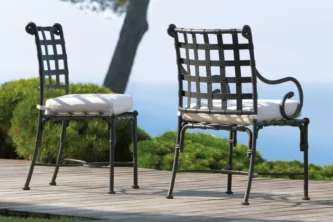
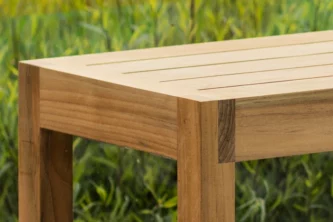
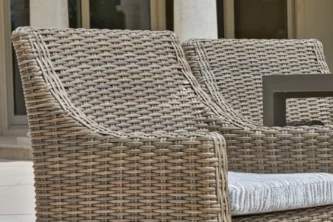
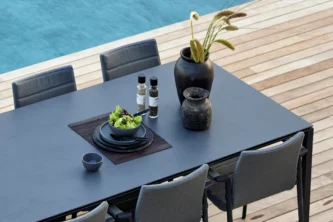
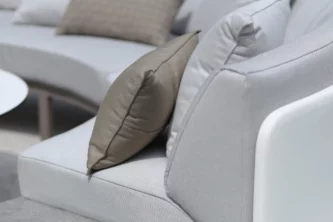





Leave a Reply